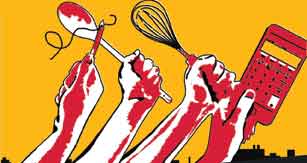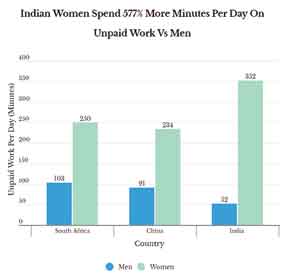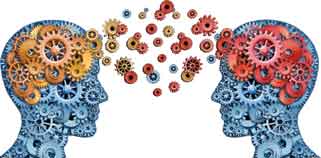What it was and what we would like it to be
Lamia Bagasrawala
Let us start with some reflections:
What do you understand by the term ‘home science’?
Which gender do you most immediately associate with home science?
Under what circumstances would you recommend home science as a professional course to a student?
As we reflect on these questions, take a moment to recognize where these ideas about home science have emerged from? What are the sources of information we have relied on? How many of these ideas are in conflict with some of our core values as educators? In what ways are we perpetuating some of these ideas? In what ways are we challenging them?
I would urge you to put down some of your thoughts before you read further. This article is a brief glimpse into the history of home science followed by reflections on the dominant discourse around the subject. As you read, I urge you to draw parallels with your own experiences as a teacher and also as a member of this society.
Tracing the origins of home science
Home science has been part of female education in India since the early 20th century. Mary Hancock, in her 2001 article titled “Home Science and the Nationalization of Domesticity in Colonial India” traces the origins of home science in British India, especially in Madras. Home science as a subject emerged as a way to reform women’s education and promote discourses on “feminist nationalism”. Feminist nationalism, in this context, is understood as a construct of nationalism that includes women’s liberation movements that were led by women identifying themselves as nationalists and feminists. In the context of colonial India, as Visweswaran (1996) suggests, feminist nationalism was a space that emerged from the negotiation between Indian nationalisms and ‘first-wave’ Eurowestern feminisms. In the 1920s, Indian feminist women’s organizations, the Women’s India Association (WIA) and the All-India Women’s Conference on Social and Educational Reform (AIWC) pioneered to institutionalize the study of home science. This move, although impacting only a few elite women, was significant in the feminist and anti-colonial nationalist discourses of India.

The home science curriculum back then was an amalgamation of the home economics course taught in the United States and the domestic science curriculum taught in England. The curriculum included domestic economy, needlework, moral education and hygiene (Hancock, 2001). While initially it was taught in the zenana and the mission schools, by the 1920s after institutionalizing the study of the course and training more teachers, the course was taught in all European secondary schools regularly and occasionally in Indian schools. Home science was classified as apolitical but it wasn’t. While most elite women were exposed to the idea of home science or home economics, through the WIA, efforts were made to make it accessible to all women. However, while women were trained, most of them were expected to put their training to use as domestic servants in the homes of the urban-elite, upper-caste, upper-class members of the WIA. The home science curriculum in India, saw its roots in feminist nationalist ideas, while containing women to the domestic sphere and upholding social constructs of class and caste. The curriculum, however, continued to gain prominence as a method that allowed women to adapt to “modernity” (Hancock, 2001). Home science, was established as a feminist nationalist project where the home would become a site for female agency.
Post-independence, home science continued to be offered in high schools in India, with a focus on feminizing and nationalizing science. By the 1950s, through advocacy, home science training was included in the community to support rural women as part of India’s development programme (Berry, 2003). With assistance from the United States, home science as a course expanded in India and began to be envisioned as a field offering professional opportunities to women in streams of applied sciences like nutrition and child development. While this was presented as India’s way of adopting a “modern” and “scientific” approach to development, what went unrecognized was the underlying politics of class, caste and gender (Berry, 2003). By the 1970s, India started offering Bachelor’s and Master’s degrees in home science which then included training in nutrition, sewing, child care, food preservation, home management and psychology.
An article published in 1912 by The British Medical Journal stated that training and healthy upbringing of children was essential for the welfare of a country and since nature and custom had “assigned” this role to women, it was imperative to train them in the field of home science. We may want to immediately term this as “regressive” and claim that we have come a long way. However, while home science has gained prominence over the last several decades as a field that empowers women to enter the workforce, have beliefs and attitudes towards the curriculum and field changed? The origins of home science are important to reflect upon, to better understand the ways in which the field has been and continues to be constructed. As educators, it is essential to explore the politics of class, caste and gender that still govern the field of home science, often too subtly.
Reflections on the current scenario
In India, at the primary education level, home economics finds a mention in the curriculum of the ICSE, CBSE, ISC and aims to cover topics like food and nutrition, resource management, human development and family studies, textiles and clothing and communication and extension. It is yet to receive recognition as a core subject in primary education. The discourse on the methods and practices, beliefs and attitudes around home science are limited in India. One of the recommendations by the Women and Child Development Ministry in the draft National Policy for Women 2017 was to make home science mandatory for all students in schools. This move may help create common forums in schools for teaching-learning of these skills. At the higher education level, however, home science continues to be part of female education predominantly. Is access to home science in school curriculum enough to challenge the notion that the domestic space is only for women?

Let us return to the questions we raised at the beginning. We are aware of the curriculum and the content that gets covered under home science. However, as educators, we need to ask how schools can strengthen their position regarding gender equality and equity. A very critical question for us to ask is, how does usage of the word “home” in the term ‘home science’ influence our and our students’ attitudes towards this subject? How does the exclusivity of home science courses for females in higher education influence students’ and the community’s perceptions about the field? We often hear that boys are now entering fields of cooking and fashion more unapologetically. However, that does not challenge the normative roles of gender played in “domestic” spaces. For instance, men are applauded as professional chefs, while cooking within home spaces continues to be perceived as a predominantly woman’s task and remains unpaid labour. In professional spaces, we find that “women-centric” occupations are made more accessible to men. However, women are yet to find similar access and parity in male dominated fields. As we contemplate on home science as a curriculum, we cannot shy away from these discussions that influence the dominant narrative and discourse around home science.
Home science as a professional field can be credited for empowering women to continue higher education and receive professional acclaim. However, as educators in schools and colleges, it is time for us to revisit the most basic principles that guide this subject. The question isn’t about renaming the course, but about recognizing that teaching home science is more than just skill building. It is about deconstructing the idea of a home or domestic space as a woman’s arena. It is about recognizing gender-based privileges and vulnerabilities. It is a process of socialization and if we aren’t reflective as educators, we may be at risk of perpetuating ideas of gender roles, identities, caste and class.
Teaching home science in schools
As educators, a fundamental question to reflect on is, in what ways can the curriculum be implemented to promote the values of equality and equity? Recognizing the gender, caste and class politics that govern perceptions and attitudes towards home science is the first step in this process. Self-reflexivity among educators to recognize their own biases and stereotypes and the school’s willingness to reflect on its own structures and pedagogy are an essential part of decolonizing education. What are my beliefs and ideas about teaching home science? As a core subject teacher, what is my attitude towards home science classes? What is the home science class labeled as in the time-table? Why have we as an only boy’s school not initiated home science? Which students are more likely to select home science as an elective in the school? Which students are considered as better candidates for home science in the school?

Another important step is to envision home science as a life-skill development programme. One that aims at not only teaching students about specific topics, but empowering them to question with curiosity, challenge and reflect on the relevance of these topics in everyday life. As Nina Asher in her 2009 chapter titled “Decolonization and Education: Locating Pedagogy and Self at the Interstices in Global Times” aptly writes, “The work of decolonization entails not only our self-reflexive efforts to work through mind-numbing alienation and essentializing divides, but also the commitment to transformation in social and educational contexts.” For instance, as students learn to cook or stitch, it is essential to equip students with knowledge and skills required to challenge and question gender norms and identities. It is important to recognize that while we may teach students to cook and stitch, we also need to empower female students to be able to question identities that are forced upon them and male students to stand as allies with them. And this is part of the process of decolonizing.
Encouraging the use of thinking routines in home science classes is an excellent way to initiate dialogue and debate. For instance, in an orientation workshop on home science, parents and students can use the Three Ys thinking routine to reflect on: Why might home science matter to me? Why might it matter to people around me? Why might it matter to the world? Such methods may allow all stakeholders to recognize the larger social underpinnings of the course. The idea, therefore, is to move beyond the content of the curriculum, to recognize the vision and objectives of a course like home science in the current context.
The role of educators and schools goes beyond just implementing the curriculum. It is essential that educators and schools take on the role of advocacy with the decision-makers in various educational boards and the policy-makers to promote an affirming learning environment. And that includes raising pertinent questions about the relevance, effectiveness and efficiency of the home science curriculum. It will require us to question the very idea of home science as it is today and ask ourselves what empowerment looks like for us. And for this, we will need to listen to the voices of women, girls and other marginalized groups within our schools. We will need to honour their stories and strengthen schools as catalysts for social change.
References
• Asher, N. (2009). CHAPTER 5: Decolonization and Education: Locating Pedagogy and Self at the Interstices in Global Times. Counterpoints, 369, 67-77. Retrieved March 22, 2021, from http://www.jstor.org/stable/42980382
• Berry, Kim. (2003). Lakshmi and the Scientific Housewife: A Transnational Account of Indian Women’s Development and Production of an Indian Modernity. Economic and Political Weekly, 38(11), 1055-1068. Retrieved March 22, 2021, from http://www.jstor.org/stable/4413343
• Hancock, M. (2001). Home Science and the Nationalization of Domesticity in Colonial India. Modern Asian Studies, 35(4), 871-903. Retrieved March 22, 2021, from http://www.jstor.org/stable/313194
• Home Science. (1912). The British Medical Journal, 1(2667), 326-327. Retrieved March 22, 2021, from http://www.jstor.org/stable/25296032
I want to congratulate the team at Teacher Plus for dedicating an entire issue to the theme of home science. While writing this article, I came across extensive literature on home science in the European and Western countries but there is dearth of contemplative, deliberate conversation around this theme in India.
I also want to recognize that discourses around education still operate with a binary view of gender and that in itself is also a barrier to achieving gender equity.
The author is a practicing psychotherapist, trainer and visiting faculty for professional graduate and postgraduate psychology programmes in Mumbai, India. She is passionate about the convergence between mental health and education and advocates for schools as communities for mental health promotion and prevention. She can be reached at lamia.bagasrawala@gmail.com.
